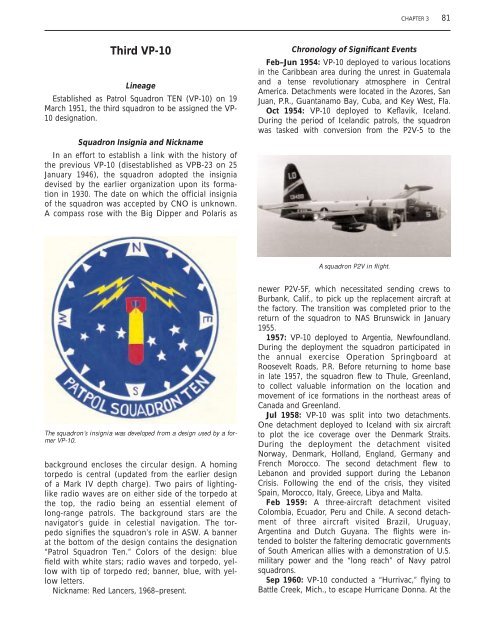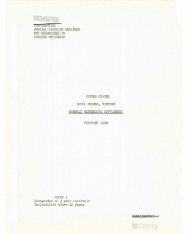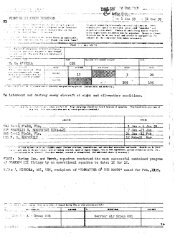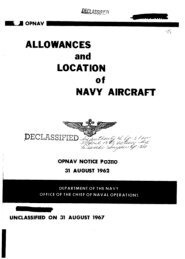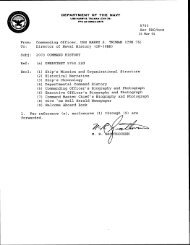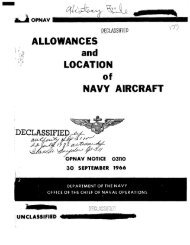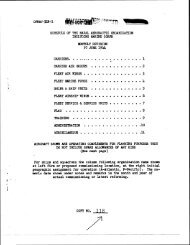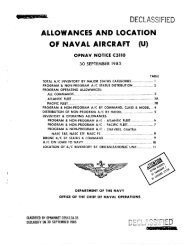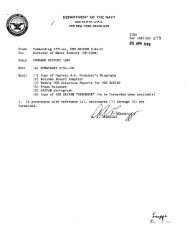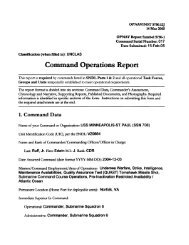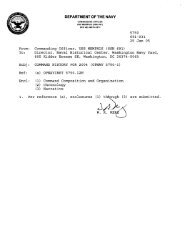VP-9 - Naval History and Heritage Command - U.S. Navy
VP-9 - Naval History and Heritage Command - U.S. Navy
VP-9 - Naval History and Heritage Command - U.S. Navy
You also want an ePaper? Increase the reach of your titles
YUMPU automatically turns print PDFs into web optimized ePapers that Google loves.
CHAPTER 3 81<br />
Third <strong>VP</strong>-10<br />
Lineage<br />
Established as Patrol Squadron TEN (<strong>VP</strong>-10) on 19<br />
March 1951, the third squadron to be assigned the <strong>VP</strong>-<br />
10 designation.<br />
Squadron Insignia <strong>and</strong> Nickname<br />
In an effort to establish a link with the history of<br />
the previous <strong>VP</strong>-10 (disestablished as <strong>VP</strong>B-23 on 25<br />
January 1946), the squadron adopted the insignia<br />
devised by the earlier organization upon its formation<br />
in 1930. The date on which the official insignia<br />
of the squadron was accepted by CNO is unknown.<br />
A compass rose with the Big Dipper <strong>and</strong> Polaris as<br />
Chronology of Significant Events<br />
Feb–Jun 1954: <strong>VP</strong>-10 deployed to various locations<br />
in the Caribbean area during the unrest in Guatemala<br />
<strong>and</strong> a tense revolutionary atmosphere in Central<br />
America. Detachments were located in the Azores, San<br />
Juan, P.R., Guantanamo Bay, Cuba, <strong>and</strong> Key West, Fla.<br />
Oct 1954: <strong>VP</strong>-10 deployed to Keflavik, Icel<strong>and</strong>.<br />
During the period of Icel<strong>and</strong>ic patrols, the squadron<br />
was tasked with conversion from the P2V-5 to the<br />
A squadron P2V in flight.<br />
The squadron’s insignia was developed from a design used by a former<br />
<strong>VP</strong>-10.<br />
background encloses the circular design. A homing<br />
torpedo is central (updated from the earlier design<br />
of a Mark IV depth charge). Two pairs of lightinglike<br />
radio waves are on either side of the torpedo at<br />
the top, the radio being an essential element of<br />
long-range patrols. The background stars are the<br />
navigator’s guide in celestial navigation. The torpedo<br />
signifies the squadron’s role in ASW. A banner<br />
at the bottom of the design contains the designation<br />
“Patrol Squadron Ten.” Colors of the design: blue<br />
field with white stars; radio waves <strong>and</strong> torpedo, yellow<br />
with tip of torpedo red; banner, blue, with yellow<br />
letters.<br />
Nickname: Red Lancers, 1968–present.<br />
newer P2V-5F, which necessitated sending crews to<br />
Burbank, Calif., to pick up the replacement aircraft at<br />
the factory. The transition was completed prior to the<br />
return of the squadron to NAS Brunswick in January<br />
1955.<br />
1957: <strong>VP</strong>-10 deployed to Argentia, Newfoundl<strong>and</strong>.<br />
During the deployment the squadron participated in<br />
the annual exercise Operation Springboard at<br />
Roosevelt Roads, P.R. Before returning to home base<br />
in late 1957, the squadron flew to Thule, Greenl<strong>and</strong>,<br />
to collect valuable information on the location <strong>and</strong><br />
movement of ice formations in the northeast areas of<br />
Canada <strong>and</strong> Greenl<strong>and</strong>.<br />
Jul 1958: <strong>VP</strong>-10 was split into two detachments.<br />
One detachment deployed to Icel<strong>and</strong> with six aircraft<br />
to plot the ice coverage over the Denmark Straits.<br />
During the deployment the detachment visited<br />
Norway, Denmark, Holl<strong>and</strong>, Engl<strong>and</strong>, Germany <strong>and</strong><br />
French Morocco. The second detachment flew to<br />
Lebanon <strong>and</strong> provided support during the Lebanon<br />
Crisis. Following the end of the crisis, they visited<br />
Spain, Morocco, Italy, Greece, Libya <strong>and</strong> Malta.<br />
Feb 1959: A three-aircraft detachment visited<br />
Colombia, Ecuador, Peru <strong>and</strong> Chile. A second detachment<br />
of three aircraft visited Brazil, Uruguay,<br />
Argentina <strong>and</strong> Dutch Guyana. The flights were intended<br />
to bolster the faltering democratic governments<br />
of South American allies with a demonstration of U.S.<br />
military power <strong>and</strong> the “long reach” of <strong>Navy</strong> patrol<br />
squadrons.<br />
Sep 1960: <strong>VP</strong>-10 conducted a “Hurrivac,” flying to<br />
Battle Creek, Mich., to escape Hurricane Donna. At the


